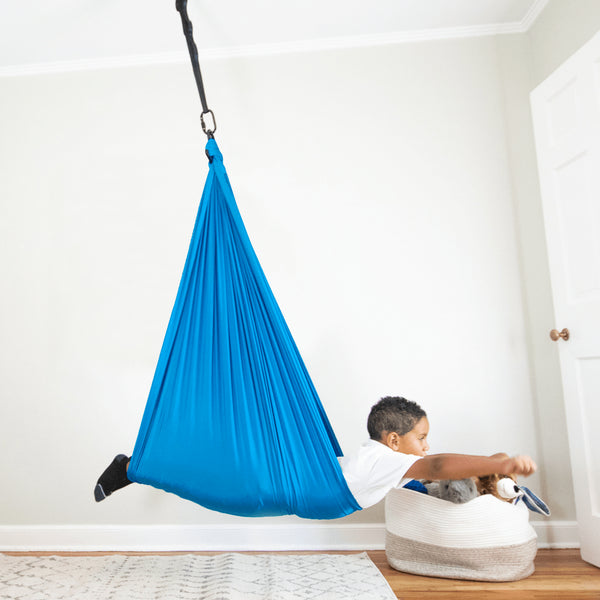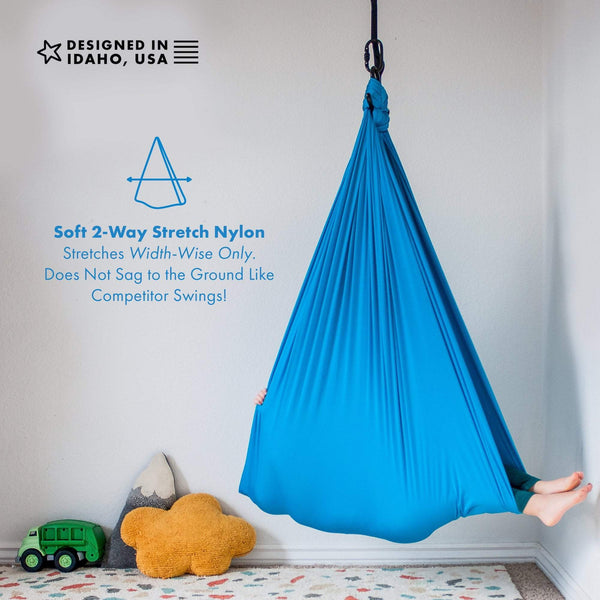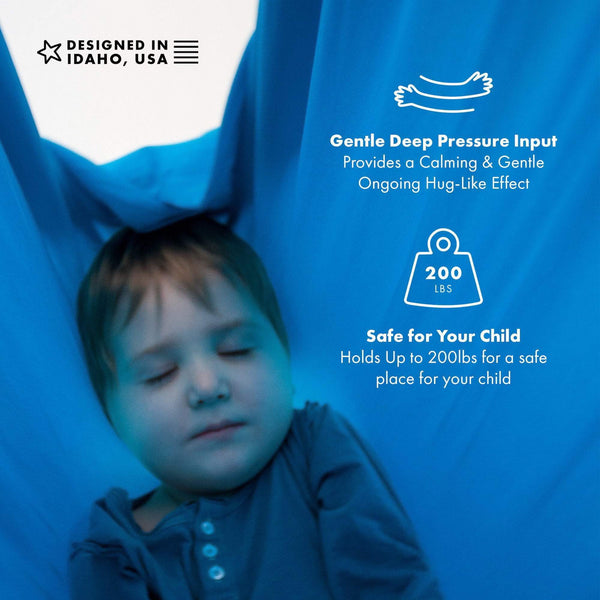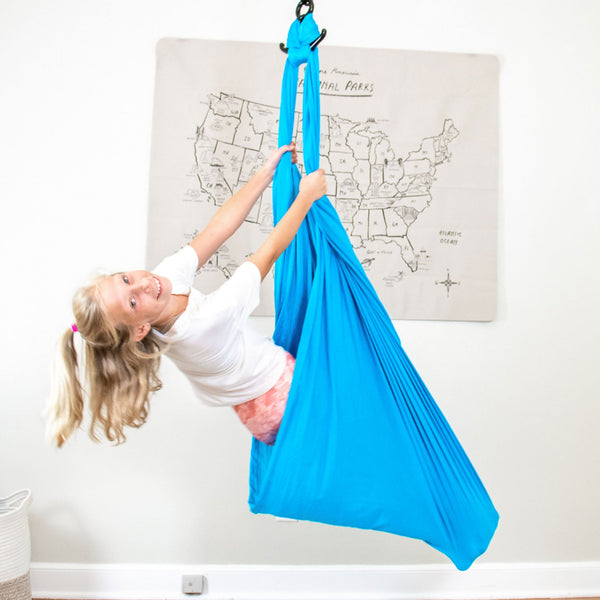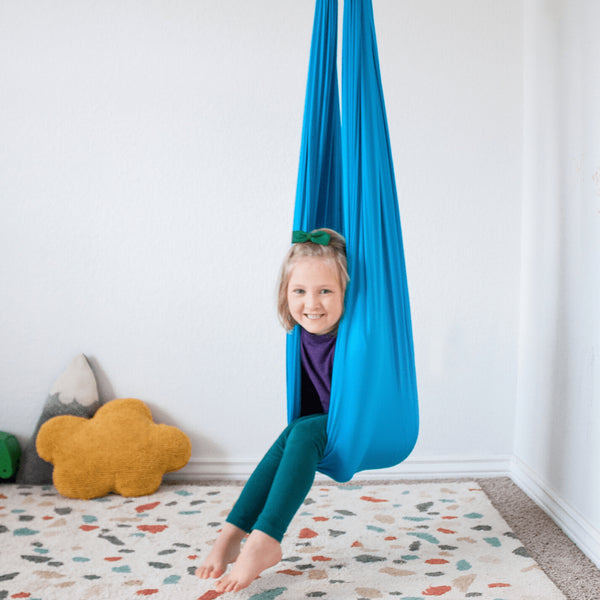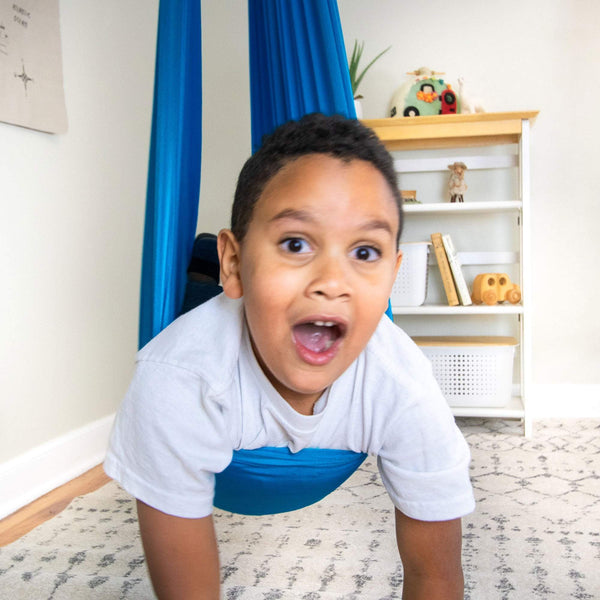Description A RELAXING PLACE FOR YOUR CHILD TO HANG
Looking for the perfect place for your child with sensory needs to relax and have fun?
Harkla's indoor therapy swing is a great addition to the bedroom or sensory room. The swing is designed to meet sensory needs:
- Compression from the swing gives a hug-like effect to your child.
- Swinging, vestibular input means the swing helps your child explore space around them and get their bearings.
Support your child by giving them a compression swing where they can self-regulate and return to calm.
STURDY & SAFE WITH EXCELLENT DESIGN - $50 OF INCLUDED HARDWARE
We've painstakingly designed our compression sensory swing to be strong and resistant. The blend of spandex and nylon is soft but durable. The swing is made to accommodate up to 300 lbs.
And you can get started with playtime as soon as the indoor swing for kids arrives. No trips to the hardware store - every purchase includes $50 in hardware at no extra cost to you!
-
2 carabiners: Makes it easy to hook it all together.
-
Daisy chain: Choose the perfect height without compromising on strength no matter where the swing is set up. *If your ceiling height is more than 12 feet, you will need an additional daisy chain.
-
Rescue 8: The most secure way to tie your compression swing.
-
Ceiling hook and screws: Attach your swing to your ceiling without worry.
Click here to shop Harkla's 360º swivel - perfectly compatible with the compression swing.
Details MATERIALS:
40 Denier | 2-Way Stretch | 100% Nylon Tricot
MEASUREMENTS:
Swing Dimensions (Unassembled): 60 inches x 110 inches
Swing Dimensions (Assembled): 48 inches x 110 inches
WHAT'S INCLUDED:
Compression Sensory Swing
Ceiling Hook
4 Bolts
2 Locking Carabiners
Rescue 8
Daisy Chain
Who We Are We think children with special needs should have every opportunity to live happy and healthy lives. That's why Harkla is dedicated to providing families with the best products and resources for raising a special needs child. Read more of our story here.
FAQS Is There An Age, Weight & Height Limit For The Swing?
The swing is designed for children 3 years or older. The swing is designed to hold up to 300 lbs and is wide enough to accommodate the height of a full sized adult.
Can I Hang The Swing Outside?
Yes! With the included daisy chain and hardware, the swing can be hung almost anywhere and is not just a sensory room swing. Wherever you are hanging it from, make sure it's strong enough for a child to play on and allows the swing to safely hang close to the ground, at most 2 feet above the ground.
Does The Swing Work With Tall Ceilings? Is The Swing Adjustable?
Yes, The swing height can be adjusted to varying ceiling heights (8-12 feet) using the daisy chain included. The daisy chain is 52" long and adds a maximum of 4 feet in additional length.
Any ceiling higher than 12 feet may require additional straps or daisy chain. The maximum recommended swing height of the seat is 2 feet (measured from the ground to the bottom of the swing).
Is The Swing Washable?
Yes, to clean the swing we recommend using a damp cloth and mild soap. If needed, you can place in a cold water delicate wash cycle and hang to dry. Do not bleach.
Does The Swing’s Ceiling Hook Have To Drill Into A Ceiling Joist Or Can It Attach Directly Into Drywall Only?
You will need a solid wood ceiling joist in order to safely attach the swing ceiling hook. The swing will not be safe to use if attaching the hook to drywall alone.
Does It Come With Hardware?
Yes, you have everything you need to hang up and use your swing right away: Ceiling hook, 4 Bolts, 2 Locking carabiners, Rescue 8 and a Daisy chain.
Can You Spin While Using The Swing?
The swing is intended to be used for static hanging and gentle swinging. Spinning is only recommended when using a swivel (sold separately). If you spin the swing without a swivel it can cause excess wear and tear of the swing fabric.
Where Do We Ship This Product?
From the Harkla Website, we only ship this product to the United States.
However, if you are looking for us in another country, we have options for purchasing!
Canada: Shop our store on Amazon Canada
Australia: Shop for us with our Australian Partner Starfish
If you're looking for another country, please check out our partner page to see if our products are available in your country through another retailer!
If you’d like to be informed of when we will be shipping to your country, please contact our customer service: support@harkla.co
Benefits What are the Benefits of Sensory Swings?
According to the STAR Institute, children with disorders in processing sensory information may have difficulty knowing where their body is.
Symptoms include: - clumsiness
- motion sickness
- frequent crashing into objects
- poor posture
- overall weakness
- feeding difficulties
- trouble with many other tasks in daily life.
This is frustrating for the child so therapy is often prescribed to help them become more confident and independent.
Most baby shower registries list a swing as a must-have item. Likewise, resort hotels often hang hammocks between gorgeous palm trees for optimal relaxation.
Swinging is not just for children but is enjoyed by people of all ages. Swinging back and forth, or linearly, is calming to almost anyone. Many look forward to taking a nap in a hammock.
The gentle sway reminds us of being rocked. In fact, our inner ear contains specific receptors designed to detect motion in all directions. Further, by providing information about movement, swinging can stimulate our sense of motion and orientation in space.
Studies have shown that one in twenty children may experience sensory processing disorder and the numbers are even greater in children with autism (Ben-Sasson et al., 2009). Many speculate that over three-quarters of all children with autism have sensory processing disorder. (Tomchek and Dunn, 2007).
Children with autism often feel dysregulated, or confused and overwhelmed within their environment. They can over-react or under-react to various noises, sensations, sights, tastes, touch and more. Many of them find the smooth rocking and swaying of a swing to help them to relax and feel soothed. They may be able to concentrate and focus better during and after movement activities.
It is for this reason therapists permit kids to fidget and move to focus. Swinging and moving can also give kids’ bodies information about where they are in "space" and in relation to their surroundings.
The stimulation of the vestibular (movement) and proprioceptive (position) senses help them to feel more in control of their body.
WHO ARE THERAPY SWINGS BENEFICIAL FOR?
SWINGING FOR SENSORY PROCESSING DISORDERS
Vestibular Processing:
If a child is struggling with vestibular processing, they seek out movement that interferes with daily activities, they are clumsy or uncoordinated, or they get motion sickness - then the compression sensory swing can be a great tool!
The vestibular system is located in the inner ear. This system is directly related to balance and vision - specifically eye movements. Because of the location in the inner ear, the vestibular system is activated with head movements. When the head moves, the eyes move and the brain and body must provide a response - balance!
When we think about vestibular input, we can think about running, jumping, spinning, and swinging. These movements activate the vestibular system and will provide a response - some people can tolerate more movement than others, while some people become easily nauseous with movement (motion sickness). Vestibular input is typically alerting to the nervous system.
The compression sensory swing provides vestibular input because it’s a swing! Depending on how you position your body in the swing, you can receive linear vestibular input - back and forth or side to side, or rotary vestibular input - spinning.
Some individuals become easily over-stimulated by vestibular input. This can cause adverse reactions such as nausea / vomiting or irritability (among others). Some individuals seek vestibular input - constantly on the move, seeking out opportunities to spin and jump.
Proprioceptive Processing:
If a child is struggling with proprioceptive processing, they seek out heavy work (such as pushing, pulling, jumping), they use too much force with tasks such as writing or playing, or they struggle with understanding where their body is in space (may seem clumsy or get hurt often) - then the compression sensory swing can be a great addition to their play items!
Proprioception is the awareness of the position and movement of the body. Sensory receptors are located on your skin, joints, and muscles. When we move, these sensory receptors send signals to our brain, telling it about the effort, force, and heaviness of the movement. Then our body is able to provide an appropriate response.
When we think about proprioceptive movement, we can also include heavy work - any type of movement that works the muscles, deep pressure - any type of input that provides pressure to our body, and vibration. Proprioceptive input is typically calming to the nervous system.
Individuals are usually not over-responsive to proprioception, meaning they don't have over-reactions to this type of sensory input. We do, however, see individuals who are under-responsive or sensory craving, meaning they want more heavy work, crashing, hugs, etc.
The compression sensory swing provides proprioceptive input through compression - almost like a hug! Because the material doesn’t have too much stretch, it provides more deep pressure than other stretchy swings.
SWINGING FOR COMPRESSION & CALMNESS
If a child is struggling with self-regulation and attention - they get frustrated easily, they cannot sit and attend to a task for an age appropriate amount of time, or they are unable to solve problems that are age appropriate - then the compression sensory swing can be a great tool!
SENSORY SWINGS FOR AUTISM, ADHD, AND MORE
If a child has a diagnosis or signs/symptoms of ADHD/ADD, Autism, Down Syndrome, Developmental Delay, cognitive / learning challenges, Apraxia, SPD, or speech/language delay, a sensory swing can be a great addition to their play and development.
More Info
Want to learn more about sensory swings and why they are so therapeutic and popular?
The therapeutic benefits of swinging come from a specific type of therapy called sensory integration therapy, which is often used to help with development for those with autism or sensory processing disorder.
Since these swings are used in therapy, you'll sometimes see them referred to as therapy swings or even autistic swings.
So, before we dive into the specifics on sensory swings, we first must look at what sensory integration is.
WHAT IS SENSORY INTEGRATION?
A pioneer in the field of occupational therapy (OT), Dr. A. Jean Ayers was both an OT and psychologist. She contributed a great deal to OT and developed a body of work discussing the theory of sensory integration.
Sensory integration explains the relationship between the brain and behavior and why individuals respond in a certain way to sensory input. Dr. Ayres described sensations of touch (tactile), vision, smell, taste, and sound (auditory). Additionally, two more senses provide information that is critical for our function in daily life against gravity. Our vestibular sense (movement and balance) provides information about where the head and body are in space and in relation to the earth's surface.
Proprioception (in joints and muscles) provides information about where and in what position our body is in space. Therapists from all disciplines now utilize sensory integration techniques in therapy.
For our full article on about sensory integration therapy, click here.
FUN & THERAPEUTIC ACTIVITIES FOR SWINGS
When children feel the need to swing, they can move their body to work on core strength as they propel back and forth. Bolster and moon swings help children to work on trunk and core muscle strengthening. By holding on with both arms and legs, they use their entire body to work together.
Remember that we all need sensory input and the ultimate goal is to have fun while doing activities that are good for our sensory, motor, and emotional systems.
DIFFERENT TYPES OF SENSORY SWINGS FOR AUTISM, SENSORY INPUTS, AND MORE
One of the most important instructions therapists give is that sensory integration therapy should be child-driven. So, the child should choose what type of swing feels best for his/her body.
Some children crave the feeling of hugs, squeezes, and deep muscle pressure. They would benefit from a compression swing that is made of stretchy material that gives a hug along with the movement. In fact, after the use of this type of swing, children may be able to pay attention and be more focused. To learn more about a compression swing and its benefits, check out the informational section below about compression swings!
The best way to choose a swing is to consult an occupational therapist to obtain a full sensory profile since children’s sensory needs can change depending on the time of day and even from one sense to another!
TIPS FOR INTRODUCING THE SENSORY SWING TO YOUR CHILD
Some children LOVE the compression sensory swing immediately - these children love to swing and move. Typically, these children do not need a “formal” introduction to the therapy swing.
However, some children are more hesitant when using the compression sensory swing - these children may have challenges processing and modulating vestibular input (meaning their body and brain struggle to process movement and balance). These are the children who many refuse to climb into the swing, who may not know how to climb in or use the swing, etc.
If your child is unsure about the sensory swing, try these tips to engage them: - Model! Get in the swing and show your child how to swing slowly. Let your child watch you have fun in the swing. Allow your child to give you a push in the swing.
- Place favorite toys in the swing and allow your child to swing their toys first.
- Suspend the swing closer to the ground so that your child is not as high off the ground.
- Allow your child to maintain a sitting position rather than laying down; it’s a lot scarier (aka more vestibular input) to lay down with legs unsupported.
- Never force your child to get in the swing unwilling. It will take them longer in the long run if we push them!
- Avoid pressuring your child to get in the swing as well. This includes positive pressure, i.e. “If you get in the swing, you can have a piece of chocolate!” Hang it up, let them explore, walk away (if safe) and when they get in on their own, don’t make a big deal about it! Just talk to them calmly about how it feels, what they think, etc.
- Put crash pads, couch cushions, a bean bag chair, or pillows and blankets under the swing to offer a safe landing if they want to crash and fall out on purpose.
- Wrap the swing up so it looks like a park swing and allow the child to put their arms over it so their legs are on the ground. They’ll have more control to swing and maneuver, while still getting a lot of input!
TIPS FOR INCORPORATING A THERAPY SWING INTO YOUR CHILD’S DAY
Incorporating the compression sensory swing into your child’s daily routine can help with self-regulation throughout the day as well as can add a play element into the day. Here are some tips for incorporating the swing into your child’s routine:
- Add the swing to the morning routine to help “wake up.”
- Use the swing as a “brain break” in between school/homework.
Offer the swing after school, before getting started on homework, chores, or extracurricular activities to reset the nervous system. - Use the swing as part of a sensory diet to help with arousal level.
- Allow your child to swing independently in order to de-stress or calm down when upset.
- Follow swinging with heavy work/deep pressure proprioceptive input activities to help reduce overstimulation.
Activities like bear crawling, wheelbarrow walking, jumping jacks, crashing on a crash pad or couch, wall push-ups, chewing gum (if safe) will help. - Use a visual timer to include a start and stop. “First we’re going to swing for 3 minutes, then we’re going to do 30 seconds of bear crawling.”
PRECAUTIONS FOR USING A THERAPY SWING
One of the main precautions when using the a sensory swing is to be mindful of the vestibular input. Vestibular input can be overstimulating for some children - if their body and brain do not process vestibular input adequately, they can display adverse reactions with too much vestibular input. “Too much” is very dependent on the child - every child is unique and will respond differently.
If your child struggles with processing and modulating vestibular input, try these tips to decrease any potential sensory overload while using the swing:
- Swing slowly vs very quickly
- When spinning, complete fewer spins with more heavy work/deep pressure breaks in between.
- Spin in both directions equally.
- Stop between each spin.
- Count how many spins and respect your child’s boundaries! The last thing you want to happen is for your child to have an adverse reaction and refuse the swing.
- Follow swinging with heavy work, as mentioned above! Proprioception helps to ground the nervous system.
- Before and after swinging, walk outside barefoot (if weather permits), jump, push on the wall, etc. to help the nervous system regulate.
Adverse reactions to vestibular input may look like:
- Nausea / Vomiting
- Irritability
- Flushed face
- Excessive dizziness
- Dilated eyes
- Aggression
- Increased arousal level (increased energy)
- Frustration
- Potentially seizures if child has a history (we recommend consulting with your child’s pediatrician if they have a history of seizures or medical conditions before completing vestibular input)
These reactions may appear immediately or several hours later.
It is recommended to always complete proprioceptive tasks (heavy work, deep pressure) after vestibular input - specifically after rotary/spinning - due to the calming effect of proprioceptive input to the nervous system. When in doubt, prop it out! :)



